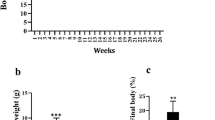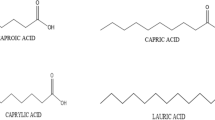Abstract
The effect of oral administration of purified (95%) eicosapentaenoic acid on serum lipids, hepatic peroxisomal enzymes, antioxidant enzymes and lipid peroxidation was compared with that of palmitic acid fed mice and corresponding controls. After 10 d, a dose of 1000 mg eicosapentaenoic acid per day/kg body weight lowered serum triglycerides by 45%, while no significant change in serum cholesterol level was noted in comparison to palmitic acid fed mice and controls. Hepatic acyl-CoA oxidase and catalase activities increased by 50% and 30%, respectively, in the eicosapentaenoic acid fed group. In addition, the hepatic reduced glutathione content and the activities of glutathione transferase, glutathione peroxidase and glutathione reductase, increased significantly during eicosapentaenoic acid treatment. The levels of hepatic lipid peroxides were lower after eicosapentaenoic acid feeding, while no significant change was noted in the palmitic acid fed mice when compared to the controls. Taken together, the present data demonstrate for the first time that at hypolipidemic doses eicosapentaenoic acid feeding i) enhances the hepatic antioxidant defense, and ii) does not cause a significant differential induction of the two peroxisomal enzymes, acyl-CoA oxidase and catalase, as was noted after administration of hypolipidemic peroxisome proliferating compounds, such as clofibrate in rodents.
Similar content being viewed by others
Abbreviations
- CMC:
-
sodium carboxymethyl cellulose
- EDTA:
-
ethylenediaminetetraacetic acid
- EPA:
-
eicosapentaenoic acid (20∶5n−3)
- GSH:
-
reduced glutathione
- HEPES:
-
N-[2-hydroxyethyl]piperazineN′-[2-ethanesulfonic acid]
- HPLC:
-
high-performance liquid chromatography
- TBARS:
-
thiobarbituric acid reactive substances
References
Sirtori, C.R., Catapano, A., and Paoletti, R. (1977)Atheroscler. Rev. 2, 113–153.
Havel, R.J., and Kane, J.P. (1973)Annu Rev. Pharmacol. 13, 287–308.
Moody, D.E., and Reddy, J.K. (1978)Am. J. Pathol. 90, 435–446.
Fahal, W.E., Lawani, N.D., Watanabe, T., Goel, S.K., and Reddy, J.K. (1984)Proc. Natl. Acad. Sci. USA 81, 7827–7830.
Goel, S.K., Lawani, N.D., and Reddy, J.K. (1986)Cancer Res. 46, 1324–1330.
Reddy, J.K., Azarnoff, D.L., and Hignite, C.E. (1986)Nature 283, 397–398.
Reddy, J.K., Lalwani, N.D., Reddy, M.K., and Qureshi, S. (1982)Cancer Res. 42, 259–266.
Reddy, J.K., and Lalwani, N.D. (1983)CRC Crit. Rev. Toxicol. 12, 1–58.
Connor, W.E., Lin, D.S., and Harris, W.S. (1981)Arteriosclerosis 1, 363a.
Goodnight, S.H., Harris, W.S., Connor, W.E., and Illingworth, D.R. (1982)Arteriosclerosis 2, 87–113.
Nestel, P.J., Connor, W.E., Reardon, M.F., Connor, S., Wong, S., and Boston, R. (1984)J. Clin. Invest. 74, 82–89.
Reddy, B.S., Burill, C., and Rigotty, J. (1991)Cancer Res. 51, 487–491.
Beck, S.A., Smith, K.L., and Tisdale, M.J. (1991)Cancer Res. 51, 6089–6093.
Small, G.M., Burdett, K., and Donnock, M.J. (1985)Biochem. J. 227, 205–210.
Lück, H. (1963)Methods Enzym. Anal. 2, 885–887.
Flohé, L., and Günzler, K.A. (1984)Methods Enzymol. 105, 114–121.
Habig, W.H., Pabst, M.J., and Jakoby, W.B. (1974)J. Biol. Chem. 249, 7130–7139.
Eklöw, W.L., Moldén, S.P., and Orrenius, S. (1984)Eur. J. Biochem. 138, 459–463.
Svardal, A.M., Mansoor, M.A., and Ueland, P.M. (1990)Anal. Biochem. 184, 338–346.
Ohkawa, H., Ohishi, N., and Yagi, K. (1979)Anal. Biochem. 95, 351–358.
Aarsland, A., Lundquist, M., Børresten, B., and Berge, R.K. (1990)Lipids 25, 546–548.
Berge, R.K., and Bakke, O.M. (1981)Biochem. Pharmacol. 30, 2251–2256.
Lalwani, N.D., Reddy, M.K., Qureshi, S.A., and Reddy, J.K. (1981)Carcinogenesis 2, 645–650.
Kappus, H., and Sies, H. (1981)Experientia 37, 1233–1241.
Author information
Authors and Affiliations
About this article
Cite this article
Demoz, A., Willumsen, N. & Berge, R.K. Eicosapentaenoic acid at hypotriglyceridemic dose enhances the hepatic antioxidant defense in mice. Lipids 27, 968–971 (1992). https://doi.org/10.1007/BF02535573
Received:
Revised:
Accepted:
Issue Date:
DOI: https://doi.org/10.1007/BF02535573




